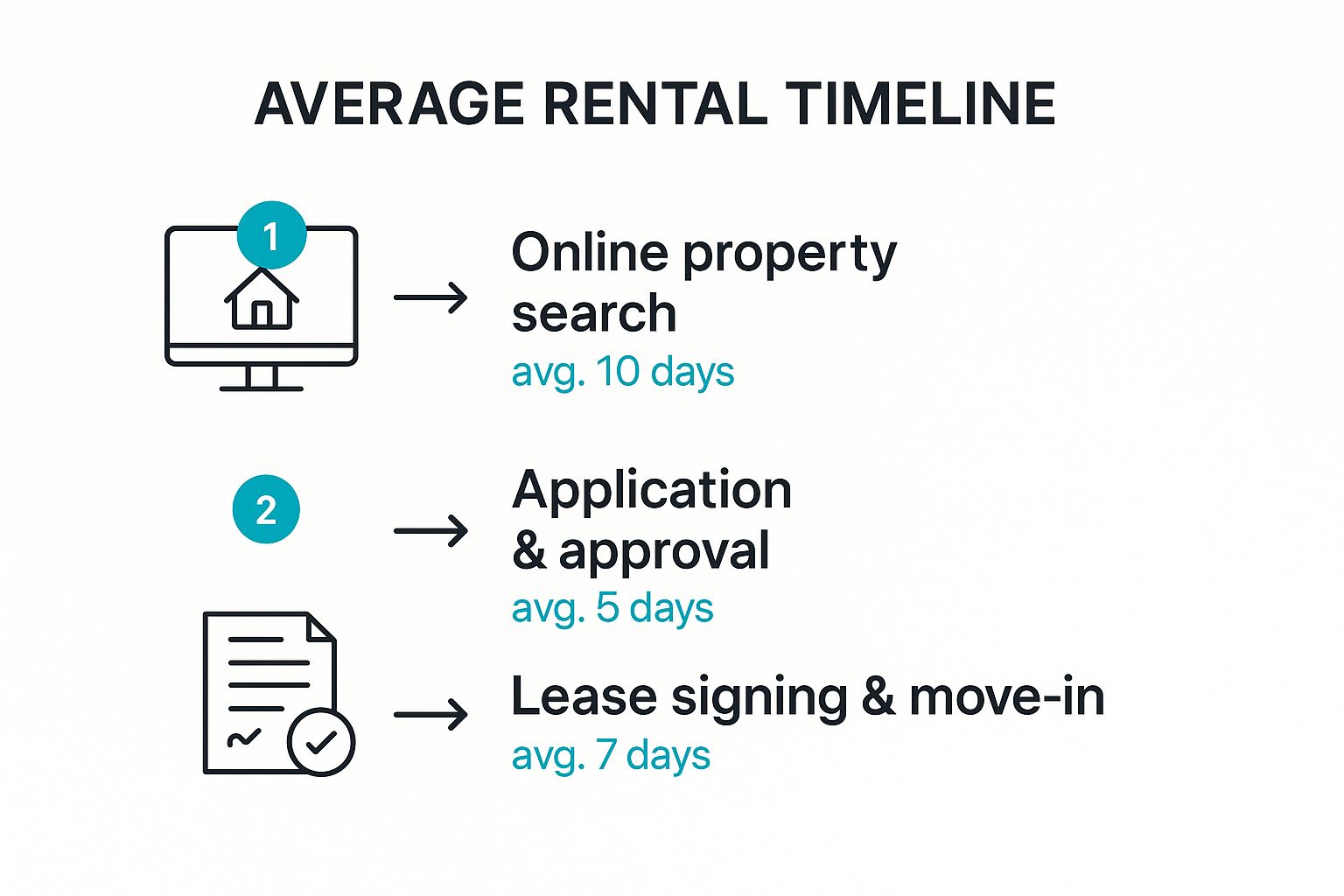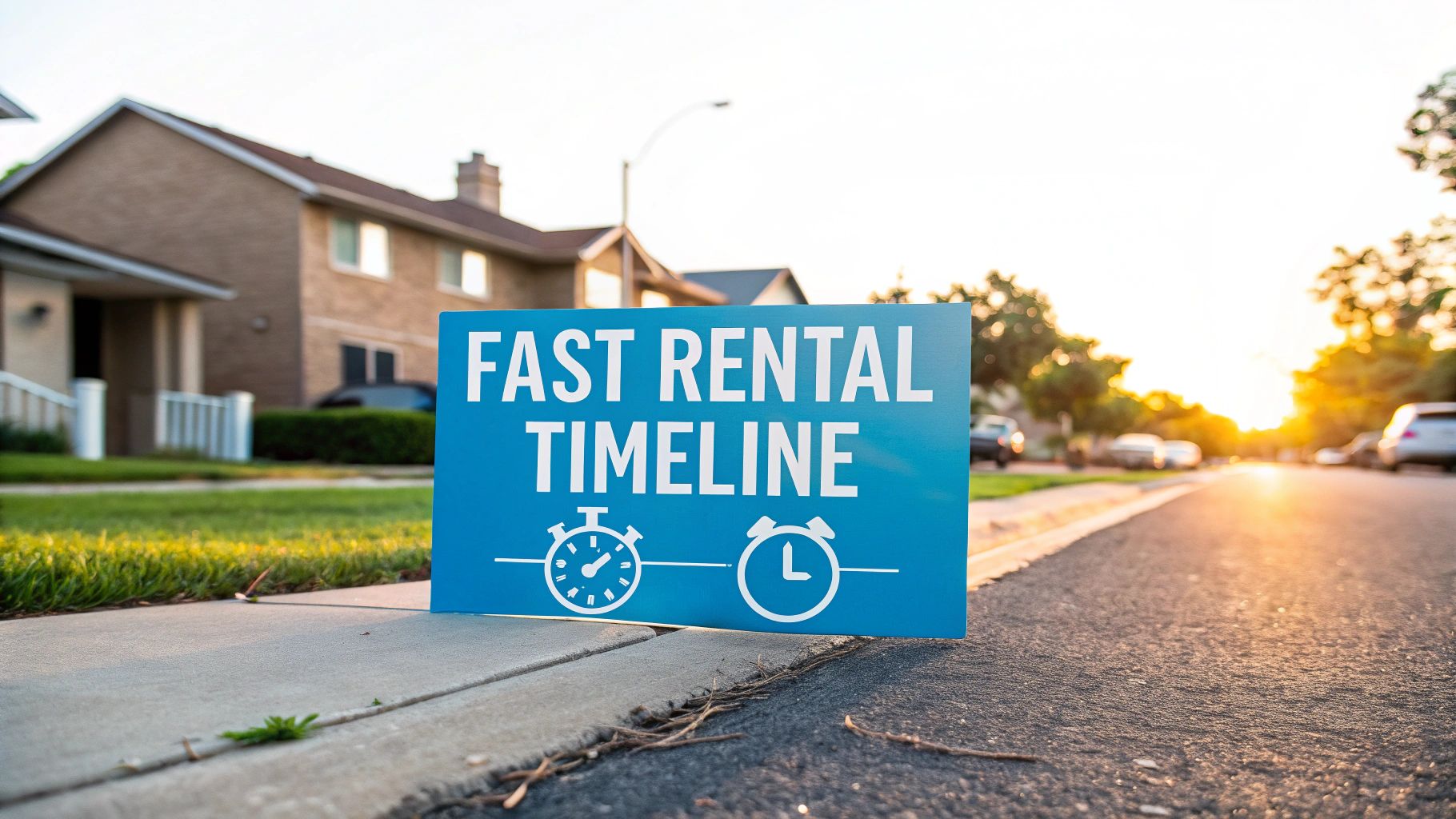For a large-scale property management company, the question "how long does it take to rent a house?" isn't a casual query—it's a core KPI that directly impacts portfolio revenue. While national averages float around for weeks, top-performing operators measure leasing timelines in days. Every day a unit sits empty is a direct hit to your bottom line, and at scale, these costs compound into a significant financial drain.
A long vacancy isn't a single-unit problem. Across a 1,000+ unit portfolio, it's an operational anchor, dragging down profitability and cost-per-door efficiency.
From Weeks to Days: The Real Rental Timeline for Enterprise Operators
When you're managing hundreds or even thousands of distributed rental units, the leasing journey is a complex operational relay. Each handoff—from making a unit rent-ready to getting the lease signed—is a potential bottleneck where days and revenue are lost.
A small delay at one stage quickly inflates your Days on Market (DOM), a critical metric for any portfolio manager. Every day of vacancy is lost rent, a cost that becomes massive when scaled across an entire portfolio.
The infographic below breaks down the typical timeline from a renter's perspective, but for an enterprise operator, each step is an opportunity to optimize and accelerate speed-to-lease.

This process often takes more than 22 days. Look closer, and you'll see huge opportunities to tighten up. For enterprise-level operators, these aren't just "waiting periods"; they're operational gaps that can be closed with the right processes and technology, turning a 22-day liability into a 10-day win.
The Key Phases Dictating Your Rental Speed
To shrink the timeline, you must understand it from an operational point of view. The entire leasing cycle boils down to four critical stages. Optimizing these phases will have the biggest impact on your portfolio's revenue.
- Property Readiness and Marketing: This is ground zero. It covers everything from turnover maintenance to getting the listing syndicated. Any lag here means the vacancy clock is ticking before you've even had a chance to generate a single lead.
- Lead Engagement and Showings: This is often the biggest chokepoint. How fast can you get an interested prospect through the door for a tour? Your speed-to-tour directly impacts your lead-to-tour conversion rate. The longer they wait, the more likely they are to lease from a competitor.
- Application and Screening: A prospect loves the place—great! Now, how easy is it for them to apply and get approved? A slow, clunky application process can cause even the most qualified renters to lose interest and walk away.
- Lease Finalization and Move-In: The final stretch. All the administrative hurdles to get the lease signed and the keys handed over can add frustrating, unnecessary delays, pushing back the day you actually start collecting rent.
The following table breaks down how traditional methods stack up against modern, tech-enabled approaches and what that means for your vacancy days.
Rental Timeline Stages and Their Impact on Vacancy
As you can see, optimizing each stage doesn't just shave off a few hours; it compounds to save days, or even weeks, of vacancy across your portfolio.
Think about it this way: for a portfolio with an average rent of $2,000, every single day you cut from the rental timeline across 500 units adds up to over $33,000 in recaptured monthly revenue.
Mastering these four phases is what separates average operators from elite, large-scale property managers. It moves renting from a passive waiting game to an active, data-driven strategy. By finding and crushing inefficiencies at every step, you can dramatically lower your DOM, protect your revenue, and boost your portfolio's financial performance.
Deconstructing the Four Phases of the Rental Timeline

If you want to shrink your rental timeline, you first have to know where the time actually goes. For any manager of a large, distributed portfolio, the real answer to "how long does it take to rent a house?" lies in mastering four distinct operational phases. Each one is a potential bottleneck where days—and serious revenue—can evaporate.
Think about it. A one-day lag in marketing or a two-day hiccup in application processing isn't a small problem. Across a thousand-unit portfolio, those small delays compound into a significant financial drain. Let's break down where time is won or lost.
Phase 1: Property Preparation and Marketing
This is ground zero. The clock starts ticking the second a tenant gives notice and doesn't stop until your listing is live everywhere. For enterprise-level operators, the goal is simple: zero downtime between tenants.
It’s an ambitious goal because delays here are incredibly common. Clunky turnover processes, waiting on vendors for repairs, or manually pushing listings to different sites can easily burn a week of vacancy before you even get your first lead. This is where automation is key. You need systems that schedule maintenance automatically and software that syndicates professional photos and a great description to dozens of rental sites in an instant.
Phase 2: Lead Management and Showings
This is where most leasing funnels spring a leak. Once a lead shows interest, speed is everything. In fact, your lead-to-tour conversion rate is one of the most honest metrics you have for measuring leasing efficiency. A prospect’s interest is red-hot for only a few minutes after they reach out.
The old way of doing things—trading emails back and forth to find a showing time—just creates friction. It gives great applicants plenty of time to get snapped up by the competition. The best-performing portfolios absolutely crush this timeline by doing two things:
- Responding Instantly: They use automated texts and emails to engage leads 24/7.
- Offering On-Demand Showings: They empower qualified leads to schedule self-tours or agent-led tours immediately, right when their interest is at its peak.
By turning the showing process from a multi-day scheduling headache into an instant, on-demand service, property managers can slash the lead-to-tour time from 72 hours to just a few minutes. This one change has a massive impact on your days on market.
Phase 3: Application and Screening
A great tour doesn't mean a thing if your application process feels like doing taxes. A long, clunky, paper-based application is a huge turn-off for modern renters. The goal should be to make applying as easy as a one-click online purchase.
Today, integrated software that lets tenants apply right from their phones is the standard for any efficient operation. These systems fast-track background and credit checks, turning a process that used to take days into a matter of hours. If you're looking for more high-impact strategies, our guide on 7 ways to lease quicker and cheaper has you covered.
Phase 4: Lease Generation and Move-In
You're at the finish line, but the final mile can be surprisingly slow. Manually drawing up leases, trying to coordinate times for everyone to sign, and physically handling security deposits can add pointless delays right when you should be closing the deal.
Digital tools are essential here. E-signature platforms allow for immediate lease signing from anywhere, and online payment portals make collecting deposits and the first month's rent a breeze. By digitizing these last few steps, you secure the tenant and get the rent clock started days faster, giving your portfolio's revenue a direct boost.
How External Market Forces Influence Your Leasing Speed
Even the most well-oiled leasing machine doesn't operate in a vacuum. If you're managing thousands of units across different markets, you know that external forces directly impact how long it takes to rent a house and shape your portfolio's performance.
Think of it this way: things like local vacancy rates, competitor pricing, and seasonality can create powerful tailwinds or headwinds for your team. Imagine a flood of new rental inventory suddenly hits one of your key markets. All at once, you’re in a real-time race against brand-new, aggressive competition. Ignoring those signals is a fast track to watching your vacancy rates creep up.
Conducting Rapid Market Analysis
To stay ahead, your operations team needs to get good at quick, ongoing market analysis. This isn't a "set it and forget it" task. It's about constantly monitoring key indicators that signal shifts in local supply and demand.
The global housing rental market was valued at $2.38 trillion in 2023 and is only expected to grow, thanks to trends like urbanization and a cultural shift toward renting. While that's great news, it also means a more crowded field where renters have plenty of options. Smart property managers use data to make sure their properties stand out. You can dive deeper into these global rental market trends by exploring the full research from dataintelo.com.
Here are the key things your team should be watching:
- Competitor Pricing: Are similar units in your area dropping their rates or offering concessions? That's a huge red flag that demand might be cooling off. You'll want to review your own pricing immediately to ensure you don't get left behind.
- Local Vacancy Rates: Keep a close eye on the vacancy numbers published by local apartment associations or data providers. If the market-wide vacancy rate is ticking up, it’s a clear sign you might need to boost your marketing or offer better incentives to attract tenants from a shrinking pool.
- Seasonal Demand: We all know leasing has its seasons. Demand skyrockets in the spring and summer, then quiets down in the late fall and winter. It's crucial to align your marketing pushes and have units rent-ready for those peak seasons to avoid long, costly off-season vacancies.
For a portfolio manager, market analysis is an offensive strategy. It's about seeing the shifts coming and proactively tweaking your pricing and marketing, not reactively slashing rents after a unit has been sitting empty for 30+ days. This protects your revenue and keeps the leasing pipeline full.
By making this kind of constant market check-up a standard part of your process, you build real resilience into your leasing operations. It ensures that no matter what the market throws at you, you have the intel to adapt on the fly, stay competitive, and keep your Days on Market low across the entire portfolio.
Optimizing the Internal Operations You Control

While you can't control market swings or seasonal lulls, you have complete authority over your own internal processes. For property managers handling large portfolios, this is where the real power to shrink your vacancy timeline lies.
It’s about shifting from a reactive waiting game to a proactive, high-velocity leasing machine. The key isn't just making tiny tweaks here and there; it’s about putting a system in place that attacks delays right at the source.
The Playbook for High-Velocity Leasing
When you're managing hundreds or even thousands of units, speed is everything. The difference between a 28-day and a 15-day vacancy isn't just 13 days—it's thousands of dollars in lost rent for every single unit. These strategies are the foundation of a modern, efficient leasing operation.
- Implement 24/7 Lead Capture and Automated Follow-Up: A prospect’s interest is red-hot the moment they reach out. An automated system makes sure every single lead gets an immediate response, whether it’s 2 PM or 2 AM. This gets them to the next step before a competitor even has a chance.
- Offer On-Demand, Self-Service Tours: Let's be honest, the biggest bottleneck in the whole process is the wait between a lead's inquiry and the actual tour. Giving qualified prospects the power to schedule and see a property on their own time—often just minutes after they inquire—is the single most effective way to close that gap and convert interested renters on the spot.
- Streamline Applications with Digital Portals: Nothing kills a deal faster than a clunky, outdated application process. Today’s renters expect a slick, mobile-friendly experience. Online portals for applications and digital lease-signing tools get rid of the administrative friction, turning a process that used to take days into something that takes just a few hours.
To really move the needle on your rental timeline, start by optimizing these internal operations and boosting your reach with the top digital marketing strategies for real estate.
Mini Case Study: Proving the ROI of Operational Optimization
Let's look at a real-world example. A property management company with 2,000 single-family rentals was stuck with a high average Days on Market (DOM) of 28 days. Their process was completely manual, with tons of back-and-forth emails just to schedule tours and process applications. Unsurprisingly, they were losing a lot of good leads along the way.
They decided to overhaul their system by bringing in an integrated leasing technology stack. This new setup automated their lead responses and, crucially, enabled on-demand self-tours. The results were immediate and frankly, dramatic.
In just six months, they slashed their average DOM from 28 days down to only 15 days. Think about that: a 13-day reduction across a 2,000-unit portfolio. The amount of recovered revenue was massive.
This just goes to show that investing in operational tech isn't an expense—it’s a high-return strategy that pays for itself. For a closer look at modern leasing tactics, check out our guide on how to lease your properties quicker in 2024.
How Property Condition Impacts Leasing Velocity
In a competitive rental market, the condition of your property isn't just about looking good—it's one of the biggest levers you can pull to control leasing speed. Especially when you're managing a large portfolio, where standardizing quality is a constant battle, a unit's condition is what makes or breaks your Days on Market (DOM).
Think about it from a renter's perspective. They walk into a pristine, move-in-ready home, and any friction in their decision melts away. On the other hand, a place with scuffed walls or old fixtures plants a seed of doubt. It screams potential maintenance headaches, and that hesitation is all it takes to send them straight to your competitor’s shinier unit down the street. These details make a huge difference in your DOM.
The Data Behind High-Demand Amenities
Making smart, data-backed decisions on property improvements is where elite operators separate themselves. You want to focus your budget on the amenities that actually lead to lower DOM and can even justify higher rent. Giving modern renters what they're actively looking for is how you create a real competitive advantage.
So, what's actually moving the needle? Market analysis consistently points to a few key features:
- Pet-Friendly Policies: This is one of the quickest ways to widen your applicant pool. A simple "yes" to pets can slash your vacancy time.
- In-Unit Laundry: The convenience is a massive selling point. For many renters, a washer and dryer in the unit is a non-negotiable.
- Smart Home Features: Things like smart thermostats and keyless entry aren't just gadgets anymore. They signal that a property is modern and well-managed, which really resonates with today's renters.
- Updated Kitchens and Baths: You don't always need a full renovation. Even small upgrades like new hardware, fresh countertops, or modern faucets can completely transform a property's appeal.
Condition, Inventory, and Leasing Speed
The current market puts the spotlight on property condition. We've seen a 17% rise in available rental inventory in just the last year, which gives tenants a lot more power and a lot more choice. While that influx of competition can feel daunting, it also creates a huge opportunity. Well-maintained properties with the right features are renting significantly faster than the rest. You can dig into more of these market dynamics in a recent rental trend analysis by ReSimpli.
For property managers with enterprise-level portfolios, standardizing your "rent-ready" condition isn't just a maintenance task—it's a core leasing strategy. When you deliver a consistent, high-quality product every time, your properties become the go-to choice for the best renters.
To keep things consistent and moving quickly, detailed move-in and move-out inspections are your best friend. Accurately documenting a property’s state is the foundation of an efficient turnover. To see just how vital this is, check out our guide on the importance of property condition reports.
At the end of the day, a superior property condition isn't an expense—it's an investment that pays you back with reduced vacancy, happier tenants, and a healthier bottom line across your entire portfolio.
Calculating the Financial Impact of Your Rental Timeline

For enterprise property managers, how long it takes to rent a house isn’t just an operational metric—it’s a direct hit to your bottom line. Every day a unit sits empty, it’s not just sitting there quietly. It’s actively costing you money.
Putting a hard dollar figure on that vacancy is the most powerful way to demonstrate the ROI of a faster leasing timeline.
The Vacancy Cost Formula for Portfolios
The math is simple, but the results are an eye-opener for large portfolios. This formula turns an abstract metric like Days on Market (DOM) into a concrete revenue leak that gets everyone’s attention, from leasing agents to the C-suite.
(Average Monthly Rent ÷ 30 Days) x Average DOM x Total Vacant Units = Monthly Revenue Loss
Let's plug in some real numbers. Imagine you manage a 1,000-unit portfolio with an average rent of $2,200 and a 21-day average DOM. If about 5% of your portfolio (50 units) is vacant at any given time, the math looks like this:
- Daily Rent Per Unit: $2,200 / 30 = $73.33
- Loss Per Vacant Unit: $73.33 x 21 days = $1,539.93
- Total Monthly Revenue Loss: $1,539.93 x 50 units = $76,996.50
That's right—the portfolio is bleeding nearly $77,000 every single month due to vacancy.
Now think about the impact of small improvements. If you could cut that DOM by just one week, from 21 days to 14, you'd instantly recapture over $25,000 in monthly revenue. This reframes leasing technology from a simple expense into a high-return investment in revenue growth.
The Inflation Multiplier
On top of that, you have to account for inflation. It’s not just a headline; it adds another layer of urgency. Over the past year, renters worldwide have seen some major rent hikes, with certain markets jumping by nearly 18%. This is happening because operational costs are rising for owners, who then have to bump up rents to protect their margins. You can see a great breakdown of how these global factors are affecting rent prices at NASDAQ.com.
As rents climb, so does the cost of every single vacant day. A $70 per day loss last year might be a $75 loss today. This "inflation multiplier" effect makes every day you can shave off your rental timeline more valuable than ever. It's a clear signal that a high-velocity leasing process is no longer a "nice-to-have"—it's critical for minimizing vacancy and maximizing revenue.
Your Top Questions About Rental Timelines, Answered
If you're managing a large portfolio, every day a unit sits empty is lost revenue. It's a constant pressure point. Here are straightforward answers to the questions we hear most from property managers focused on getting leases signed faster and boosting portfolio performance.
What’s a Realistic Goal for Cutting Down Days on Market?
For a portfolio with 500+ units, aiming for a 25-30% reduction in Days on Market (DOM) within six months is a solid, achievable goal once you begin optimizing your leasing process. You get there by zeroing in on the biggest time-sinks, like slow lead response and tour scheduling bottlenecks.
The top operators in the game consistently keep their DOM under 14 days, but they're usually using a full suite of automation tools like Showdigs. The first step is to benchmark where you stand now. From there, you can chip away at each stage of the leasing cycle for small wins that add up to major revenue recovery across your portfolio.
How Does Technology Actually Help Rent a House Faster?
Think of technology as a system that relentlessly attacks delays. A good tech stack doesn't just speed things up; it removes the manual hurdles that slow your team down, creates a consistent process for every property, and gives you the data you need to keep improving.
- Smart Lockboxes & On-Demand Showings: These are game-changers. They give qualified renters instant access to a property, 24/7, right when they're most excited to see it, dramatically improving lead-to-tour conversion rates.
- CRM & Automation Tools: This software acts like a perfect front desk, making sure every single lead is captured and gets a response in minutes. That alone can make a huge difference.
- Digital Applications & Lease-Signing: Moving these processes online shaves days off your administrative time. What used to be a back-and-forth hassle becomes a few quick clicks, getting you to a signed lease and an occupied unit that much faster.
What Is the Single Biggest Driver of Rental Speed?
Hands down, the biggest impact comes from implementing an on-demand or self-service showing system. The single greatest point where you lose potential tenants is in the gap between their first inquiry and the moment they actually step inside the property.
Think about it: when a renter is fired up to see a home, making them wait days for a tour is like pouring cold water on a hot lead. By letting qualified prospects tour a home within hours—or even minutes—of asking, you engage them at their absolute peak interest. This one change can easily slice a week or more off your average leasing time, directly adding to your portfolio's bottom line.
Stop letting slow, outdated leasing processes eat into your revenue. Showdigs provides the leasing automation platform built to slash your Days on Market by enabling on-demand tours and streamlining your entire lead-to-lease funnel for large, distributed portfolios. See how you can accelerate your leasing operations and boost your portfolio's ROI.







